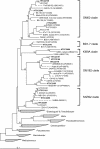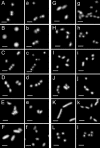Cultivation and growth characteristics of a diverse group of oligotrophic marine Gammaproteobacteria
- PMID: 14711672
- PMCID: PMC321273
- DOI: 10.1128/AEM.70.1.432-440.2004
Cultivation and growth characteristics of a diverse group of oligotrophic marine Gammaproteobacteria
Abstract
Forty-four novel strains of Gammaproteobacteria were cultivated from coastal and pelagic regions of the Pacific Ocean using high-throughput culturing methods that rely on dilution to extinction in very low nutrient media. Phylogenetic analysis showed that the isolates fell into five rRNA clades, all of which contained rRNA gene sequences reported previously from seawater environmental gene clone libraries (SAR92, OM60, OM182, BD1-7, and KI89A). Bootstrap analyses of phylogenetic reliability did not support collapsing these five clades into a single clade, and they were therefore named the oligotrophic marine Gammaproteobacteria (OMG) group. Twelve cultures chosen to represent the five clades were successively purified in liquid culture, and their growth characteristics were determined at different temperatures and dissolved organic carbon concentrations. The isolates in the OMG group were physiologically diverse heterotrophs, and their physiological properties generally followed their phylogenetic relationships. None of the isolates in the OMG group formed colonies on low- or high-nutrient agar upon their first isolation from seawater, while 7 of 12 isolates that were propagated for laboratory testing eventually produced colonies on 1/10 R2A agar. The isolates grew relatively slowly in natural seawater media (1.23 to 2.63 day(-1)), and none of them grew in high-nutrient media (>351 mg of C liter(-1)). The isolates were psychro- to mesophilic and obligately oligotrophic; many of them were of ultramicrobial size (<0.1 micro m(3)). This cultivation study revealed that sporadically detected Gammaproteobacteria gene clones from seawater are part of a phylogenetically diverse constellation of organisms mainly composed of oligotrophic and ultramicrobial lineages that are culturable under specific cultivation conditions.
Figures




References
-
- Béjà, O., M. T. Suzuki, E. V. Koonin, L. Aravind, A. Hadd, L. P. Nguyen, R. Villacorta, M. Amjadi, C. Garrigues, S. B. Jovanovich, R. A. Feldman, and E. F. DeLong. 2000. Construction and analysis of bacterial artificial chromosome libraries from a marine microbial assemblage. Environ. Microbiol. 2:516-529. - PubMed
-
- Bowman, J. P., S. M. Rea, S. A. McCammon, and T. A. McMeekin. 2000. Diversity and community structure within anoxic sediment from marine salinity meromictic lakes and a coastal meromictic marine basin, Vestfold Hilds, Eastern Antarctica. Environ. Microbiol. 2:227-237. - PubMed
Publication types
MeSH terms
Substances
Associated data
- Actions
- Actions
- Actions
- Actions
- Actions
- Actions
- Actions
- Actions
- Actions
- Actions
- Actions
- Actions
- Actions
- Actions
- Actions
LinkOut - more resources
Full Text Sources
Other Literature Sources
Molecular Biology Databases

